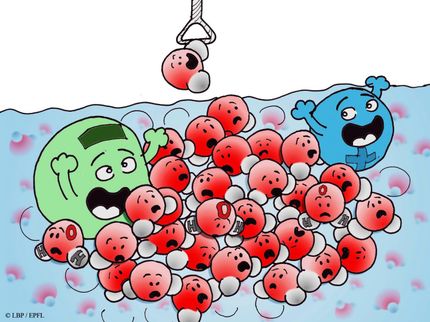Highly stable foams by the attachment of silica nanoparticles to bubble surfaces
Advertisement
Foams are gas bubbles confined by fluid or solid boundaries. Whereas solid foams are quite stable, most fluid foams quickly collapse. To stabilize foams, surface-active reagents or proteins are generally used. British researchers have developed foam stabilizers that are more effective: highly disperse silica nanoparticles.
Why do foams collapse? The fluid surrounding the gas bubbles slowly flows downward and partially evaporates. As a result, the lamellae between vesicles becomes thinner and thinner. The bubbles at the surface eventually burst, other bubbles fuse, and small bubbles shrink in favor of larger ones. Bernard Binks and Tommy Horozov discovered that miniscule silica nanoparticles can counteract this effect. The particles attach themselves to the surfaces of the small bubbles. Standard surface-active reagents do this as well, but nanoparticles differ in that they do not detach from the bubble surface. The secret to the success of the nanoparticles is their finely balanced hydrophobicity. This can be controlled by the manner in which the hydrophilic silica nanoparticles are purposefully covered with a water-repellent layer. The more hydrophobic the particles become, the more firmly they press themselves into the air-bubble surface. The nanoparticles cannot be completely hydrophobic, however, as this would impede their hydration by water altogether. Silica particles work best with intermediate hydrophobicity.
Under the microscope, bubble surfaces appear corrugated. The bubbles are covered with a closely packed layer of particles. It is possible that such stable bubbles are formed by the fusing of smaller bubbles, which themselves are not as well-covered with particles. As a given volume defined by many small bubbles has a larger surface area than the same volume in fewer, larger bubbles, the process of bubble fusion eventually creates the appropriate available space for the nanoparticles. As the particles cannot become detached, they move ever closer together, and the surface corrugates. The closely packed nanoparticles protect the air bubbles from collapse, and thus stabilize the foam.
Most read news
Topics
Organizations
Other news from the department science

Get the chemical industry in your inbox
By submitting this form you agree that LUMITOS AG will send you the newsletter(s) selected above by email. Your data will not be passed on to third parties. Your data will be stored and processed in accordance with our data protection regulations. LUMITOS may contact you by email for the purpose of advertising or market and opinion surveys. You can revoke your consent at any time without giving reasons to LUMITOS AG, Ernst-Augustin-Str. 2, 12489 Berlin, Germany or by e-mail at revoke@lumitos.com with effect for the future. In addition, each email contains a link to unsubscribe from the corresponding newsletter.




























































